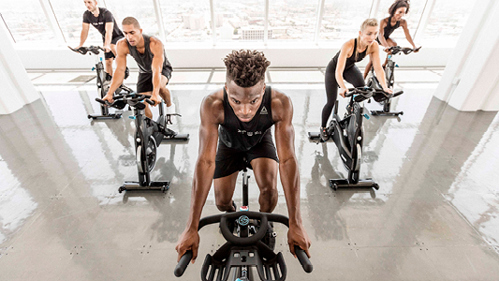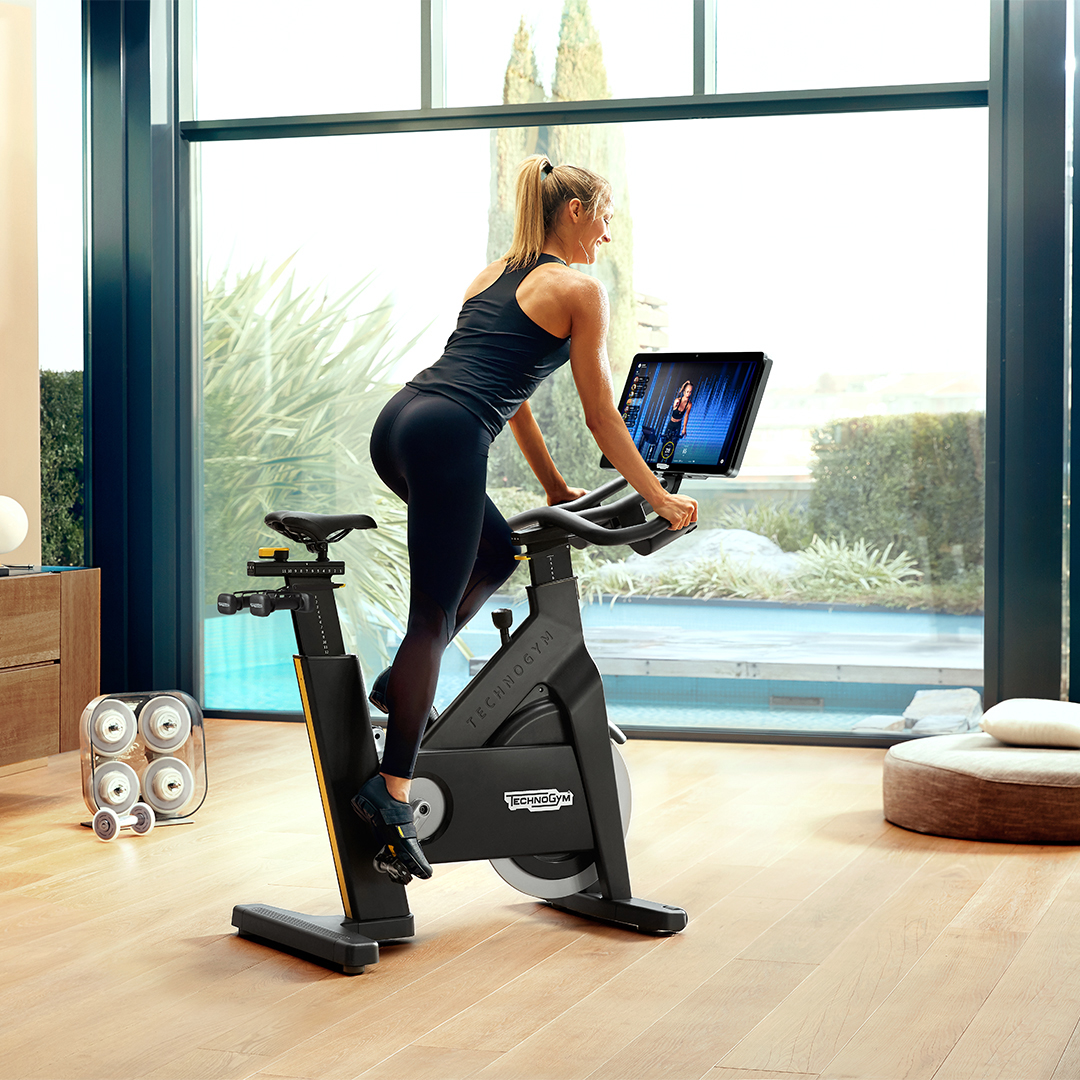-
Build your aerobic capacity with endurance rides
Try longer rides at a relatively low-intensity pace if HIIT cycling seems daunting or you’d prefer a comfortable effort you can hold for a long time. An endurance ride can last for up to five hours or more, but riding for anywhere between 90 minutes and 3 hours can boost your cycling workout, whether that’s done by extending your commute or usual local bike ride.
How to do it
Extend your short cycle for between 90 minutes and 3 hours, maintaining a steady effort throughout.
Why it works
An endurance ride helps with building your aerobic capacity, such as boosting the number of capillaries that deliver oxygen-rich blood to your muscles and can give your cells more energy.
-
Include a social ride in your training
Working out with friends has multiple benefits including keeping us motivated when things get tough, and cycling is no different. You’re more likely to stick to your exercise plan if you pair up with friends and adding a little spontaneity can be a great way to get your heart rate up.
How to do it
For maximum benefit, find a course with plenty of rolling hills and focus on going hard on those climbs or go more informal in an orderly rotation.
Why it works
Pairing up friends can add the fun factor to training and you’re more likely to have greater mental benefits from your exercise too.
-
Add some interval training to increase endurance and performance
HIIT class is one of Village Gym’s most popular exercise classes as it helps boost metabolism and promotes high calorie burn in a short space of time. From using a jumping rope to a stair climbing machine, there’s a number of methods that are used to achieve results from HIIT, but you can also incorporate it into your bike rides.
The HIIT method is particularly effective for those who are strapped for time, with efforts requiring anywhere from a couple of seconds to a minute to achieve in short bursts, two to three times a week.
How to do it
Using either your own bicycle or a bike at your local gym, the aim of HIIT is to alternate between high-intensity periods of exercise and rest periods for the duration of your workout.
To begin, you’ll need to start with a warm-up of between 5 and 10 minutes of gentle cycling. A classic HIIT workout to try involves 30 seconds of all-out cycling, followed by another 30 seconds of gentle cycling. Repeat for 20 minutes, and ensure you finish with around 5 minutes of gentle cycling and stretches to cool down and prevent muscle soreness.
Why it works
HIIT is a proven way to boost metabolism, burn those calories, reduce fat and improve cardiovascular health. Choosing to get on your bike for your workout helps improve your speed, power and overall endurance.
-
Take to the hills and improve your stamina
If you’re looking to take your casual biking to a whole new level, a great way to test your endurance is to move beyond flat ground and challenge yourself with short climbs to build stamina.
How to do it
Start with shorter, easier climbs once you feel comfortable on flat ground. Try riding hard up a hill for a minute, before descending at an easy pace then repeat around four or five times. You can then gradually extend the length of these repeats, until you are able to climb for four minutes, eight times over.
Why it works
Cycling hill repeats can boost your aerobic capacity, improve your stamina and supercharge your mitochondria, also known as the membrane-bound energy powerhouses within your cells.

-
Mix up the pace of your ride for greater calorie burn
Look to mix up a gentle bike ride by incorporating different paces and adding resistance to your usual routine. For greater calorie burn, you’ll want to move beyond a moderate speed and add challenge.
How to do it
Start with simple stretches such as stretch quads or touching your toes with your legs straight, then warm up by cycling on your bike at a gentle pace for about five minutes. Work up to a faster speed and maintain for a further five minutes, then bring your speed down for two to four minutes.
To create a challenge, either raise the resistance or ride up a hill and maintain for between three to five minutes, then even out to a cruising pace for two minutes. Once more, increase the speed again and maintain for three to five minutes then go for another round of resistance or uphill cycling for three minutes, recovering for two minutes.
Make sure to stretch at the end to cool down to prevent muscle soreness for about five minutes.
Why it works
Adding variation to your workouts are an easy way to challenge yourself and get stronger. It’s likely you’ll hit a plateau if you carry out the same workout time after time, so look to move beyond your limits if your goal is to improve.
-
Slow down with a recovery ride
It’s just as important to know when to recover from training as it is to apply maximum effort, and that’s where a recovery ride comes into play. After a hard training ride, a recovery ride can help reduce muscle soreness and boost your mental health.
How to do it
Ride for 30-60 minutes on a flat course, and cycle easy. If you are using heart rate or power, you should be in zone 1.
Why it works
Adding cooldown methods to your workout is an essential way to prevent injury and enhance the recovery process after a hard training ride. A recovery ride increases blood flow to the legs and helps to reduce inflammation.
-
Improve your power with cadence drills
If you’re looking to improve your power and efficiency on a bike, consider cadence drills as an efficient method for developing greater muscular endurance. Cadence, or RPM (revolution per minute) means the number of times your pedal turns over per minute and repeating it over and over, can aid in smoother pedalling and more effective power transfer.
How to do it
Alternate between a minute at 100 RPM and a minute at 90 RPM at an endurance or tempo effect for ten minutes, pedal easy for three to five minutes and repeat that cycle two to three times.
Why it works
Cadence drills are a relatively low-intensity workout that can help you develop neuromuscular control and help to produce more consistent power.
-
Get some help from technology
Technology fitness tracking watch, track your workouts and effort, apps that help track your fitness over time, apps that provide structured workouts, as well as apps that track your ride routes, help you to connect with your bike-riding friends and help you track your speed and distance.
How to do it
Download the Strava app - Record your ride maps and stats, publish them to a network of friends, and compete to get on to the leaderboard on small segments throughout your ride.
Download the TrainingPeaks app - Provides structured workouts to follow and tracks your training.
Download the Komoot app - Provides local routes to follow and directions, attach your phone to your handlebar and go exploring further afield!
Why it works
Keeping a track of your training and fitness progress, or just tracking your bike ride routes to share with friends can really keep up your motivation to get out and ride. Consistency is key, so seeing progress happen, getting encouragement from friends and having a record of how much work you’ve put in over time can really give you that boost each day to keep going on your fitness journey
Learn more about cycle workouts:
-
Find out our top bike tips for beginners
-
Discover our guide to Les Mils RPM cycle class
-
Learn about Les Mils The Trip™ indoor cycling class complete with cinema screen and sound
-
Explore the different cycle classes we have on offer
About the author
Lee Clayton is a Gym & Leisure Club Manager / Personal Trainer in Village Gym Warrington, former Bantamweight Professional Boxer with 14 years of PT experience including training professional athletes. Also coaches HYROX and is a Les Mills group fitness instructor among many other classes.
Specialisms: Fitness Classes, PT, Boxing, Combat Sports, Nutrition, Weight Loss, Muscle Gain, Strength Training.


